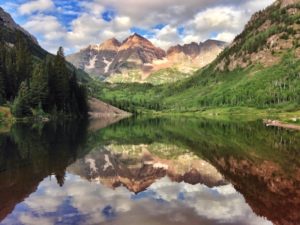Tips for Riding at Altitude on a Colorado Bike Tour
How to Ride Successfully at High Altitude
There’s a reason so many elite cyclists train at high altitude: it increases the body’s ability to breathe more efficiently with limited oxygen, especially useful when they compete at lower altitudes. Those are the cyclists you see sprinting by their competition, hardly breaking a sweat. However, for the rest of us mere mortals, “high altitude” means we breathe harder and deeper. And sometimes, it means altitude sickness. Not everyone gets it (only 1 in 4 people) and being physically fit doesn’t protect you from it. The symptoms are not unlike a bad hangover: headache, feeling tired, lack of appetite, nausea and vomiting.
Fortunately, there are steps you can take to minimize the effects and reduce your risk. As one of the “lucky” people to have experienced altitude sickness once, I always follow these and have been altitude sickness-free ever since.
 Get Acclimated
Get Acclimated
If at all possible, arrive at your high-altitude destination (let’s say, Colorado!) a few days (2-3) before you start your bike tour. Staying in Denver at 5,280′ will help you ride at +7,000′ much better. If you can’t manage 2-3 days, give yourself at least one day to relax and adjust to the new climate. Your body will thank you! There are 100+ miles of bike trails in the Denver metro area, so you’ll have plenty of opportunities to test your cranks a wee bit in your acclimation days, if you want.
Drink Up and Often
One thing you’ll notice in Colorado (or anywhere in the West and Southwest) is a preponderance of water bottles. Everyone takes one everywhere because it’s high and dry out there. Drink even more water than normal (1-2 quarts extra) and start doing so 3-5 days BEFORE you arrive at your destination. Staying hydrated is key to staying happy at high altitude. If you can avoid caffeine and alcohol (major dehydrators) in the first few days that’ll help your body adjust, too.
Put in the Good Stuff

Riding in Colorado is a phenomenal experience and one that gives you bragging rights for years to come. Being prepared and taking some simple steps will help ensure that your time isn’t spent suffering altitude sickness. If you’re still concerned about riding at high altitude, talk with your doctor because some medical conditions may be aggravated by high elevation, such as heart and lung diseases or diabetes.
Ready, set, let’s go! Our Colorful Colorado bike tour is specifically and lovingly designed for those of us who live at sea-level, (or darn close) and really love to visit Colorado. Most touring companies have steep climbs and descents on the passes of the Rockies. We have carefully selected almost 50% rail-trail type terrain that includes friendly grades, not quad-squishing climbs. Check out the Colorado bike tour details to learn more.


 Get Acclimated
Get Acclimated